- Best ResultsVariable
- Treatment Recovery2-7 days
- Procedure Time15 minutes
- Skin SpecialistNot required
- Duration of ResultsShort lived
- AnaestheticNA
- Back to Work0-3 Days
- CostNot offered anymore. Read more.
Kleresca Acne Treatments
Kleresca® is a treatment that uses the principles of photodynamic therapy to treat acne. It is an exercise of marketing basic formulations of photoactive chemicals, activated by blue light. Regardless, it can be effective for some patients with zits, pimples, & nodules. It does not treat blackheads & whiteheads. Read more to understand why I am not a fan of this treatment.
FactsFacts on the Kleresca® Program for acne
- Kleresca is an effective method for the treatment of inflammatory acne
- It uses 2 spectrums of blue LEDs to activate a cream that kills bacteria
- Kleresca is most effective if you suffer papular or pustular acne (AKA Zits)
- This treatment is not effective in treating blackheads & whiteheads
- The Kleresca Program consists of 12 treatments spanning over 6 weeks
- BBL or AviClear in my option is a better treatment
- Remission from acne is at best 6 months
- There are far more effective, less costly treatment for acne
What is Kleresca?
Put simply it is an exercise in strategic marketing. Kleresca uses a gel that is sensitive to blue light. This gel is concentrated in the acne lesions, more specifically in the sebaceous or oil glands. This oil gland is rich in bacteria known as c.acnes.
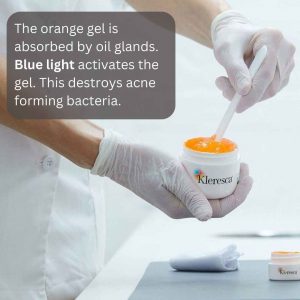
The blue light source of Kleresca activates the gel within the oil gland, in turn causing oxidative stress to the bacteria. This also reduces oil production due to the collateral inflammation within the oil glands itself. Read more to understand why I am not a fan of this treatment.
How long is the Kleresca Program and when can I expect to see results?
The program is over 6 weeks and consists of 12 treatments. 2 treatments are performed over a week. (You must leave at least one day in between treatments.)
Most patients notice an improvement within 4 weeks of treatment. Though the treatment cycle lasts 6 weeks, your acne may continue to improve after you stop the Kleresca Program.
Kleresca is not indicated for blackheads & whitehead acne. The remission rate (as per marketing guidelines) is 6 months at maximum. Hence expect to pay between $2400 to $4400 a year to maintain your results. Factor in 4 years of acne & you would have spent the greater part of 15K. This is why I don’t like the marketing principles behind Kleresca (seriously unethical marketing, aimed solely at company profits).
How is Kleresca performed?
Kleresca® is administered twice a week for six weeks. A nurse or practitioner will apply a topical orange gel that is illuminated under a multi-wavelength LED light for nine minutes. This is an in-clinic treatment.
Is this treatment painful?
No. The treatment offers you a comfortable experience- you will feel warmth on your skin during the procedure towards the end of your treatment.
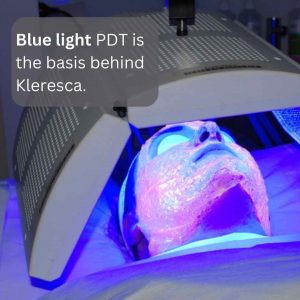

View our Treatment Gallery
What is the advantage of Kleresca over other acne treatments?
This treatment does not involve the use of tablets or drugs, just low-level laser LED and BioPhotonic cream. This means no synthetic drugs enter your body, as the treatment targets the pimple forming bacteria in your oil glands.
Unlike Accutane, your acne does not worsen before improving. Roaccutane works by ‘pushing out’ your oil glands at a molecular level- this means acne usually gets worse before getting better.
Additionally, phototherapy works quicker than retinoid therapy. As a guide antibiotics and creams take 12 weeks before working, and Accutane takes 8- 12 weeks before a change is seen, after the initial flare up. Phototherapy with LED sources such as blue, red light as well as filtered IPL & BBL can give faster results.
*At Cutis, our medical dermatologists prefer the use of blue light filtered BBL – IPL over Kleresca. Why? Because you require less sessions with BBL, the results are faster, there is no bronzing of the skin (compared to Kleresca) & BBL is cheaper.
How permanent is this treatment?
If you are lucky, you will get 6 months out of it, however, if combined with other medications, the rate of remission increases. There are no limits as to how many Kleresca treatment programs you can be on, it really depends if you want to spend 2K a year for a decade.
To give a balanced viewpoint on acne treatments, there is no treatment that guarantees remission, even isotretinoin has a recurrence rate of 30 to 40%. The remission rate of PDT & Kleresca is thought to be much lower.
Acne a complex interplay of genetics & extrinsic factors, can’t control much non-pharmacologically bar diet & lifestyle
.
🍧Diet: I am quite surprised by how much of an impact diet makes, but unlike a weight loss diet, an anti acne diet is hard to follow, it means a total elimination of flares such as dairy, sugar, hormonal fed produce & refined foods. With caloric restriction, you can have cheat days, or make it up by burning more calories, you can’t do that with an acne free diet. Kudos for the motivated, it’s such a discipline 👊🏻
.
😎Davin Lim
Dermatologist
Brisbane🇦🇺
.
#dermatology #skincare # #drdavinlim #davinlim #brisbanedermatologist #acne #acnediet #acetips #acnecure #acneremedy #naturalacneremedy #pimples #acnefree #acneskincaretips
What is your take on this?
.
👉Here is mine… my team & I revise scars on a daily basis. Most of our patients exceed the ‘severe’ grade 4 ruling by a factor of ten. A lot of these case can be prevented😞
.
💯Scars play a huge role in the physical & emotional well being of patients, we understand that. Patients travel from around Australia & the other end of the world to get treatments
.
💰💵Look, we get it, business is a commercial venture. There is however, a cross over when it comes to medical ethics. If a patient has a few pimples & would like cleaner skin, yes, there is an argument that they are a sitting target for sales. Heck, #Proactive does it, so does #Kleresca & many other companies. Market away
.
🤬Where I get p*ssed off is when acne is medical. Take for example cystic acne, scarring acne or deep painful hormonal acne. These forms of acne have a high incidence of acne scars. They also frequently give emotional scars that can be lifelong
.
👉In these groups of patients (not clients, not consumers), acne treatments should be managed ethically with remission in mind, not commercially. Tell it like it is, let the patient decide
.
👌🏻I have been supporting Scition for 15 years. I think it’s in the top 3 IPL/BBLs out there. We use their devices daily, we also use their BBL to treat acne, however my team has never had the brief to upsell this treatment, in fact it’s the opposite, we encourage medical therapy over light based modalities. We acknowledge that in some cases, this is the preferred treatment👍🏻
.
👉The name of Forever Clear is not ethically correct. In fact, it is misleading. If it was the name of a drug, the company would have been sued within an hour of launching, or it wouldn’t have gained FDA, CE or TGA approval. Not a chance
.
😎Davin Lim
Dermatologist
Brisbane🇦🇺
.
#dermatology #IPL #scitonbbl #foreverclear #bluelighttherapy #acnetips #acnetreatment #drdavinlim #davinlim #acne #brisbanedermatologist #laserclinics #cysticacne #hormonalacne
How safe is this treatment?
Kleresca is one of the safest acne treatments available. In fact the blue light of the Kleresca LED by itself is a safe & effective treatment for acne (without the ALA- Biophotonic gel).

Unlike Accutane or antibiotics there are no side effects, apart from temporary staining of your skin (bronzing). There are no allergic reactions to Kleresca, unless one has a genetic susceptibility to porphyrins.
How many treatments are included in the Kleresca program?
Twelve. Kleresca® is administered twice a week for six weeks. You must have at least one day’s break between treatment sessions.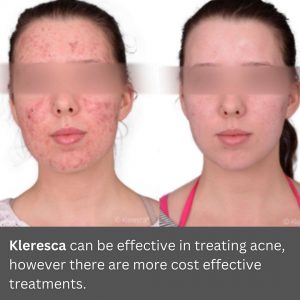
Though there are many clinics selling single treatments, ALA-PDT & stand-alone blue light LED required multiple sessions. A hack that will save you money (& get fast results), is to undertake one Kleresca treatment but ensure you are on medical therapy for your acne. Why so? Because medical therapy is slower to work but has a much more predictable & cost effect end result. Discuss this with your dermatologist.
Can Kleresca be combined with other treatments?
Absolutely. In fact, phototherapy is ideal for patients who want faster results with long term remission.

Retinoids take 6 to 12 weeks before kicking in, hence using the blue light wavelength of the Kleresca lamp (with or without the Biophotonic gel), can result in faster clearance. Discuss the role of LLED or BBL -IPL with the blue light filter with your dermatologist.
A sensible combination of blue light (using the Kleresca lamp or another source), is to combine it with topical retinoids, retinol, BHAs, anti-inflammatory agents or even oral isotretinoin. The action spectrum for drug induced photosensitivity is in the long wave UVA, not in the longer blue spectrums of the Kleresca light source.
Combining the Biophotonic gel (or better/cheaper ALA) with blue light (or red light) will give most patients an accelerated clearance over topical or systemic (tablets) for acne.
How much does this treatment cost?
The Kleresca Program consists of 12 sessions spaced over 6 weeks. This procedure is performed at cosmetic GP practices as well as shopping center-based laser clinics. The prices range from $2390 to $2590 for a series of treatments.
Individual treatments are around $249. Note, this treatment ideally involves a series of treatments, not one.

In my practice, I do believe that blue + red light LED phototherapy is nearly as effective as ALA-blue light (Kleresca). I do think that combination therapy with medically prescribed topicals (retinoid) give far superior results at the 6 month mark and beyond. Additionally, the combination of blue light phototherapy & topical is far more cost effective than Kleresca.
What is a better treatment for acne?
AviClear is a new laser treatment due in Australia in 2023. It uses 1726 laser light to specifically target oil glands. AviClear requires far less treatments than Kleresca. 3 sessions in total over 3 months.

AviClear, unlike Kleresca will not stain your skin, & can be safe & highly effective in treating ethnic skin types.
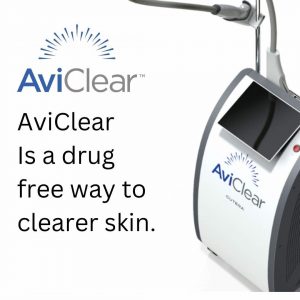
How do I start Kleresca® Program?
The very first step is a careful assessment to see if you are suitable for Kleresca. Not all patients are suitable candidates.
Ideal candidates for this treatment include –
- Patients seeking a natural remedy without the use of tablets.
- Patients with primarily papular -pustular acne (no blackheads).
- Patients who do not want to undertake tablets including Accutane- Roaccutane.
- Patients who have had bad side effects to Accutane- Roaccutane in the past.
NOTE- Kleresca works best if you have papular-pustular and cystic acne, namely zits. It does not work well for blackheads- whitehead acne.
You can get this treatment done in various skin clinics. The dermatologists at Cutis do not offer this treatment as we believe there are far better, cheaper & more effective treatments for patients with acne.
What treatments are more effective than Kleresca?
Lots. Ideally if you have nodular cystic acne or pimples & papules with scarring, you should be under the care of a dermatologist. This is because scarring can be permanent. Not everyone can afford or have access to a dermatologist hence why I write content about DIY acne treatments. If you are serious about acne, do the following, it is far cheaper & more cost effective than Kleresca, with better long-term results-
- Refer to the page on acne diets. No dairy, low sugar. Supplement with zinc sulphate from a health food store.
- Start on a retinoid, ideally Epiduo or Differin. If you are in Australia, see your GP. They may start you on some anti-inflammatory antibiotics for short term management. Use 2% BHA or salicylic acid was, as tolerated. As tolerated is an important concept to understand.
- If you have inflammatory acne, IPL, BBL, vascular lasers, blue & red light, LLED can help. You do not need the ALA gel found in Kleresca. Save your money. High energy levels with the above devices will result in better results. If you have blackheads, see a good dermal therapist, esthetician, or skin care expert who will treat you without the marketing bullsh*t. Extractions, peels & exfoliation can help.
- Practice good skin care. Remove make up before bed time, let your skin breathe. Use a simple bland moisturizer, especially if you are on a retinoid
- If you exhibit scarring, don’t waste your time on fluffy stuff including Kleresca. See a medical dermatologist for treatment. The number one predictive factor for scarring is the time taken to effective acne control.

Anti-acne diet may work in some cases. It requires marked discipline with no cheat days.
Is Kleresca subsidized under Medicare?
No. Some International Private health insurance companies cover the entire program, some give a partial rebate. Australian Private Health insurance companies do not cover the Kleresca® program.
There are many effective treatments subsidized by the PBS, your dermatologist can give you options.
Note: I am a procedural dermatologist. I cut, laser, peel & inject. I do not practice any acne management. Please see my colleagues at Clinic Cutis.
Who to see if you are serious about effectively treating acne?
If you are serious about effectively treating acne in both the short and long term, see a medical dermatologist, but before that, practice all the goodness of diets & DIY skin care. Refer to the relevant sections.
Dermatologists prescribe effective medications & not fairy dust. They do not go for the prescription pad & scribble Witch Hazel or tea tree oil (however if you are inclined to go for the natural route, knock yourself out). Derms employ methods such as clinical phototherapy, lasers, chemical peels, topical vitamin A as well as tablets to get your acne under control in the shortest amount of time. If you are serious about acne, see a dermatologist.
Disclaimer: I do not treat acne. My work sub specializes in managing objectively severe acne scars. My colleagues at Clinic Cutis will treat your acne.
Davin’s viewpoint on the Kleresca Program
Kleresca is a good example of marketing by pharmaceutical companies. I was involved in the early launch of this product under Leo Pharma. I used Kleresca for over 18 months in my practice to understand the protocols, side effects, & expected results both short & long term. Here are my thoughts-
Kleresca can be effective, but it is not suitable for everyone. This treatment is suited for patients who want an effective, safe, no downtime acne treatment that is relatively quick to work with little or no systemic side effects. The gripe I have with this treatment is the commercialisation of their target market. We know that remission is rarely seen with this treatment, hence patients may spend over 2-4 thousand dollars a year, for many years (this can be argued that the treatment is ideal for the company involved).
The marketing strategy of Kleresca targets inflammatory nodular cystic acne as their target patients. We know this cohort of patients are most prone to acne scarring & post inflammatory hyperpigmentation. This subset of patients may undertake many months to years of non-medical treatments only to have more acne scars due to recurrence & chronicity of acne. Not cool, not ethical.
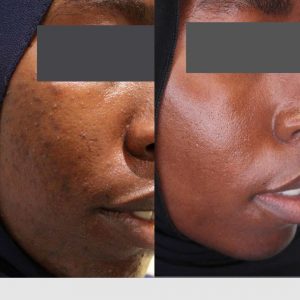
Ideally Kleresca should be combined with other acne treatments under the supervision of a medical dermatologist. Why? Because the aim of therapy is to provide long term solutions (not short-term cash to the company). Additionally, a medical dermatologist can step up the treatments should scarring occur. Though Kleresca marketing makes the point that this therapy has scar remodelling properties– namely low-level laser emission can also help improve early and mild acne scarring, the long term remission is in doubt.
I am not against clinics providing acne solutions for patients, what I dislike about Kleresca & their marketing is that they target the patients who are more prone to long term acne scars & recurrence of their acne. This is the primary reasoning why I do not endorse the ethics of this company.



